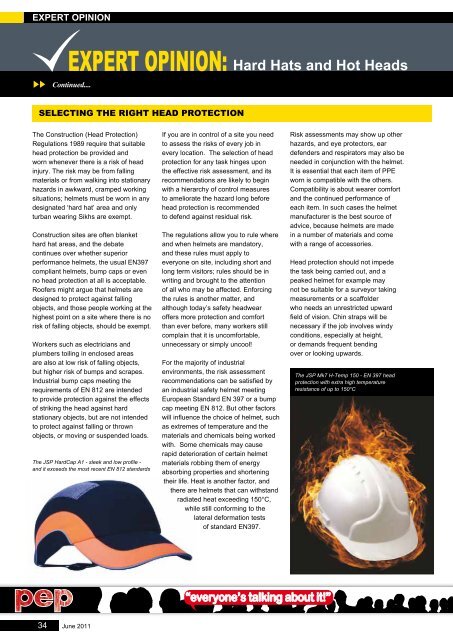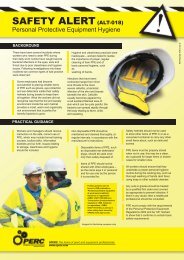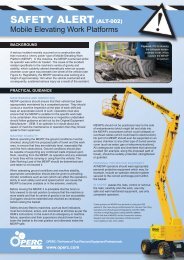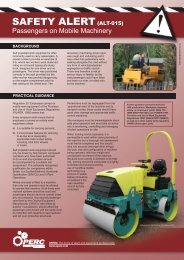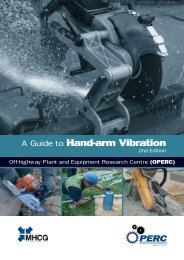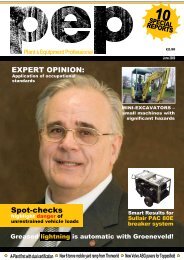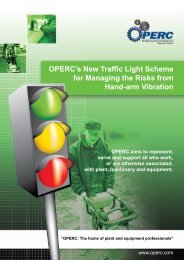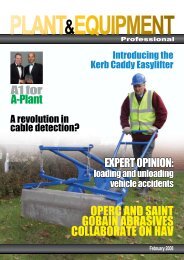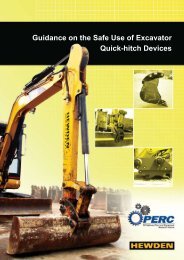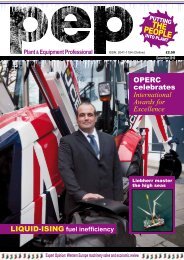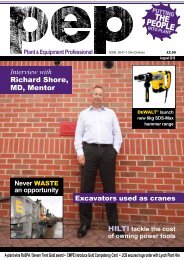expert opinion: - OPERC - Off-highway Plant and Equipment ...
expert opinion: - OPERC - Off-highway Plant and Equipment ...
expert opinion: - OPERC - Off-highway Plant and Equipment ...
You also want an ePaper? Increase the reach of your titles
YUMPU automatically turns print PDFs into web optimized ePapers that Google loves.
ExPERT oPINIoN<br />
34<br />
exPert oPinion: Hard Hats <strong>and</strong> Hot Heads<br />
Continued....<br />
selecting the right heaD Protection<br />
The Construction (Head Protection)<br />
Regulations 1989 require that suitable<br />
head protection be provided <strong>and</strong><br />
worn whenever there is a risk of head<br />
injury. The risk may be from falling<br />
materials or from walking into stationary<br />
hazards in awkward, cramped working<br />
situations; helmets must be worn in any<br />
designated ‘hard hat’ area <strong>and</strong> only<br />
turban wearing Sikhs are exempt.<br />
Construction sites are often blanket<br />
hard hat areas, <strong>and</strong> the debate<br />
continues over whether superior<br />
performance helmets, the usual EN397<br />
compliant helmets, bump caps or even<br />
no head protection at all is acceptable.<br />
Roofers might argue that helmets are<br />
designed to protect against falling<br />
objects, <strong>and</strong> those people working at the<br />
highest point on a site where there is no<br />
risk of falling objects, should be exempt.<br />
Workers such as electricians <strong>and</strong><br />
plumbers toiling in enclosed areas<br />
are also at low risk of falling objects,<br />
but higher risk of bumps <strong>and</strong> scrapes.<br />
Industrial bump caps meeting the<br />
requirements of EN 812 are intended<br />
to provide protection against the effects<br />
of striking the head against hard<br />
stationary objects, but are not intended<br />
to protect against falling or thrown<br />
objects, or moving or suspended loads.<br />
The JSP HardCap A1 - sleek <strong>and</strong> low profile -<br />
<strong>and</strong> it exceeds the most recent EN 812 st<strong>and</strong>ards<br />
June 2011<br />
If you are in control of a site you need<br />
to assess the risks of every job in<br />
every location. The selection of head<br />
protection for any task hinges upon<br />
the effective risk assessment, <strong>and</strong> its<br />
recommendations are likely to begin<br />
with a hierarchy of control measures<br />
to ameliorate the hazard long before<br />
head protection is recommended<br />
to defend against residual risk.<br />
The regulations allow you to rule where<br />
<strong>and</strong> when helmets are m<strong>and</strong>atory,<br />
<strong>and</strong> these rules must apply to<br />
everyone on site, including short <strong>and</strong><br />
long term visitors; rules should be in<br />
writing <strong>and</strong> brought to the attention<br />
of all who may be affected. Enforcing<br />
the rules is another matter, <strong>and</strong><br />
although today’s safety headwear<br />
offers more protection <strong>and</strong> comfort<br />
than ever before, many workers still<br />
complain that it is uncomfortable,<br />
unnecessary or simply uncool!<br />
For the majority of industrial<br />
environments, the risk assessment<br />
recommendations can be satisfied by<br />
an industrial safety helmet meeting<br />
European St<strong>and</strong>ard EN 397 or a bump<br />
cap meeting EN 812. But other factors<br />
will influence the choice of helmet, such<br />
as extremes of temperature <strong>and</strong> the<br />
materials <strong>and</strong> chemicals being worked<br />
with. Some chemicals may cause<br />
rapid deterioration of certain helmet<br />
materials robbing them of energy<br />
absorbing properties <strong>and</strong> shortening<br />
their life. Heat is another factor, <strong>and</strong><br />
there are helmets that can withst<strong>and</strong><br />
radiated heat exceeding 150°C,<br />
while still conforming to the<br />
lateral deformation tests<br />
of st<strong>and</strong>ard EN397.<br />
“everyone’s talking about it!”<br />
Risk assessments may show up other<br />
hazards, <strong>and</strong> eye protectors, ear<br />
defenders <strong>and</strong> respirators may also be<br />
needed in conjunction with the helmet.<br />
It is essential that each item of PPE<br />
worn is compatible with the others.<br />
Compatibility is about wearer comfort<br />
<strong>and</strong> the continued performance of<br />
each item. In such cases the helmet<br />
manufacturer is the best source of<br />
advice, because helmets are made<br />
in a number of materials <strong>and</strong> come<br />
with a range of accessories.<br />
Head protection should not impede<br />
the task being carried out, <strong>and</strong> a<br />
peaked helmet for example may<br />
not be suitable for a surveyor taking<br />
measurements or a scaffolder<br />
who needs an unrestricted upward<br />
field of vision. Chin straps will be<br />
necessary if the job involves windy<br />
conditions, especially at height,<br />
or dem<strong>and</strong>s frequent bending<br />
over or looking upwards.<br />
The JSP Mk7 H-Temp 150 - EN 397 head<br />
protection with extra high temperature<br />
resistance of up to 150°C


